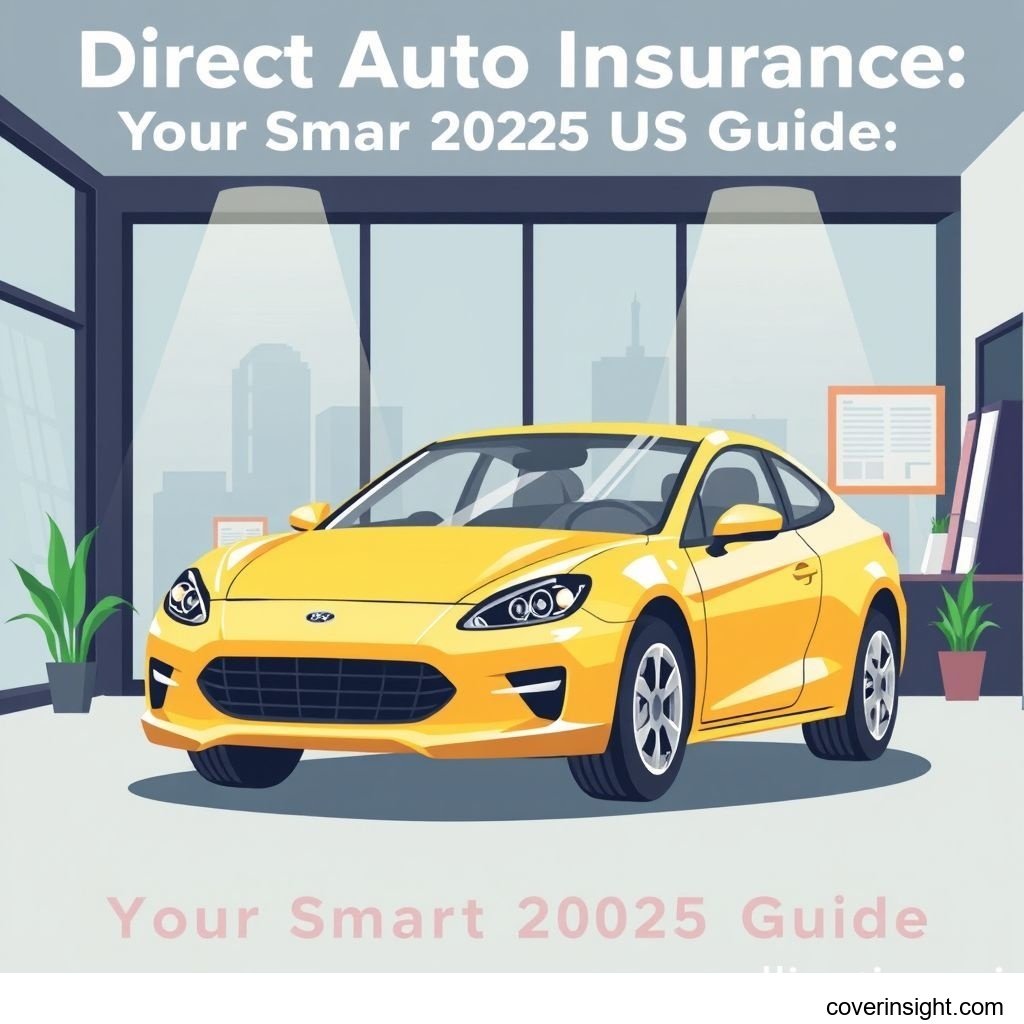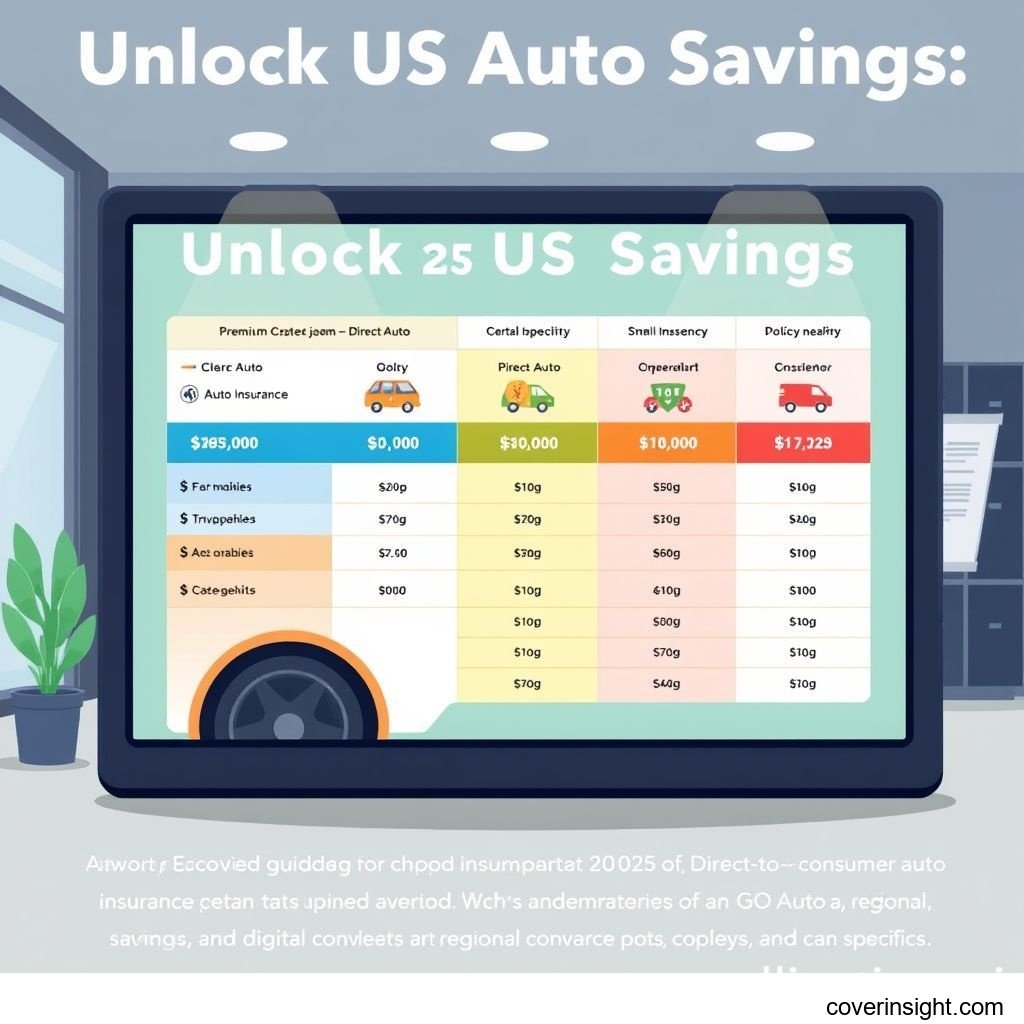Direct Auto Insurance: Your Smart 2025 US Guide
Introduction
The landscape of auto insurance in the United States continues to evolve, and by 2025, direct auto insurance has solidified its position as a go-to choice for millions. This model, which bypasses traditional agents and allows consumers to interact directly with the insurer, offers unparalleled convenience and often, competitive pricing. In today’s fast-paced world, understanding your options and making informed decisions about your auto coverage isn’t just smart; it’s essential for both your financial well-being and your peace of mind on the road.
Coverage Details
What’s Included
Direct auto insurance policies, much like those from traditional providers, offer a comprehensive suite of coverage options designed to protect you from various financial liabilities arising from accidents or incidents. At its core, you'll find the fundamental requirements:
-
Liability Coverage: This is the cornerstone. It covers damages and injuries you might cause to others in an at-fault accident. It typically includes Bodily Injury Liability (for medical expenses, lost wages, and pain and suffering of others) and Property Damage Liability (for damage to other vehicles or property).
-
Collision Coverage: This pays for damages to your own vehicle resulting from a collision with another vehicle or object, regardless of who is at fault.
-
Comprehensive Coverage: Think of this as protection against non-collision incidents. It covers theft, vandalism, fire, natural disasters (like hail or floods), and even hitting an animal.
-
Personal Injury Protection (PIP) or Medical Payments (MedPay): These cover medical expenses for you and your passengers after an accident, regardless of fault. PIP can also cover lost wages and essential services. States often mandate one or the other.
-
Uninsured/Underinsured Motorist (UM/UIM) Coverage: This is a vital safeguard, especially given that, according to the Insurance Research Council, approximately 1 in 8 drivers nationwide were uninsured in 2023. UM/UIM protects you if you're hit by a driver without insurance or with insufficient coverage to pay for your damages and injuries.
Many direct insurers also offer add-ons like roadside assistance, rental car reimbursement, and gap insurance for financed vehicles, allowing you to tailor a policy that truly fits your needs. For a deeper dive into consumer experiences, explore our [Direct Auto Insurance Reviews 2025: US Guide].
Common Exclusions
While direct auto insurance provides robust protection, it's crucial to understand what's typically not covered. Common exclusions often include:
-
Intentional Damage: Causing damage to your vehicle on purpose.
-
Wear and Tear: Routine maintenance, tire blowouts due to age, or normal deterioration of parts are generally not covered.
-
Using Your Vehicle for Commercial Purposes: If you use your personal car for ride-sharing, delivery services, or other commercial ventures without specific commercial auto insurance, your personal policy likely won't cover incidents that occur during those activities. This is a common pitfall.
-
Racing or Illegal Activities: Damages incurred while racing, off-roading in an unauthorized area, or participating in illegal activities are almost universally excluded.
-
Modifications Not Declared: Significant aftermarket modifications that aren't declared and approved by your insurer might not be covered if they contribute to a loss.
Understanding these exclusions is just as important as knowing what’s included to avoid any unwelcome surprises down the road.
Cost Analysis
Price Factors
The cost of direct auto insurance isn't a one-size-fits-all number; it's a complex calculation based on numerous individual factors. Insurers look at your specific risk profile to determine your premium. Key factors include:
-
Driving Record: A clean record with no accidents or violations is your best friend here. Speeding tickets or at-fault accidents can significantly hike up your rates. For example, a single at-fault accident in Texas can, on average, increase your premium by over 40% for years.
-
Vehicle Type: The make, model, year, and even color (though less impactful than popular myth suggests) of your car play a role. Sports cars and luxury vehicles typically cost more to insure due to higher repair costs and theft rates.
-
Location: Where you live and primarily park your car matters immensely. Urban areas with higher traffic density, crime rates, and accident statistics generally lead to higher premiums than rural areas.
-
Age and Gender: Younger, inexperienced drivers, particularly males under 25, statistically present a higher risk and therefore face higher premiums.
-
Credit Score: In many states, your credit-based insurance score is a significant factor. A higher score often indicates a more responsible individual, translating to lower premiums.
-
Annual Mileage: The more you drive, the higher your risk of being in an accident, which can slightly increase your premium.
-
Deductible: This is the amount you pay out-of-pocket before your insurance kicks in. A higher deductible typically means a lower premium.
Saving Tips
No one wants to pay more than they have to for insurance, and direct auto insurers often offer plenty of ways to trim down your premium without sacrificing essential coverage. Here are some smart saving strategies:
-
Shop Around: This is perhaps the most impactful tip. Don't settle for the first quote. Direct insurers make it easy to get multiple quotes online. You might be surprised by the price variations for the same coverage.
-
Bundle Policies: Many direct insurers also offer home, renters, or life insurance. Bundling multiple policies with the same provider often results in significant multi-policy discounts.
-
Maintain a Clean Driving Record: This goes without saying, but avoiding tickets and accidents is the best long-term strategy for lower rates.
-
Increase Your Deductible: If you have an emergency fund, consider raising your collision and comprehensive deductibles. This lowers your premium, but ensures you can cover the initial out-of-pocket cost if an incident occurs.
-
Look for Discounts: Direct insurers offer a myriad of discounts:
-
Good Student Discount: For young drivers with good grades.
-
Defensive Driver Course Discount: Completing an approved safety course.
-
Multi-Car Discount: Insuring more than one vehicle on the same policy.
-
Low Mileage Discount: If you don't drive much.
-
Safety Features Discount: For cars with features like anti-lock brakes, airbags, or anti-theft devices.
-
Pay-in-Full Discount: Paying your annual premium upfront instead of monthly installments.
-
Telematics Programs: Some insurers offer devices or apps that monitor your driving habits (speeding, braking, mileage) and reward safe drivers with lower rates.
-
-
Improve Your Credit Score: As mentioned, a better credit score can lead to lower rates in many states. For comprehensive consumer resources on insurance and financial health, consulting bodies like the [National Association of Insurance Commissioners] (NAIC) or even general government sites like [Healthcare.gov] for broader consumer protection information can be beneficial, though the latter focuses on health, the principles of smart consumerism apply across the board.
FAQs
-
How much does direct auto cost?
There's no fixed price tag. The cost of direct auto insurance varies widely based on individual factors like your driving history, vehicle type, location, age, and chosen coverage limits and deductibles. It could range from a few hundred dollars to several thousand per year. The best way to find out is to get personalized quotes online.
-
What affects premiums?
Premiums are primarily affected by your risk profile. Key factors include your driving record (accidents, violations), the type of vehicle you drive, your location (urban vs. rural), your age and gender, your credit-based insurance score, and the amount of coverage and deductible you select.
-
Is it mandatory?
Yes, almost every state in the US mandates some form of auto insurance, typically liability coverage. The minimum requirements vary by state. For precise details on your state's minimums, it’s wise to check your local [State Insurance Departments] website. Driving without the legally required coverage can lead to significant penalties, including fines, license suspension, or even vehicle impoundment.
-
How to choose?
Choosing the right direct auto insurance involves balancing cost with adequate coverage. Start by assessing your needs – what kind of coverage do you require? How much can you afford for your deductible? Then, compare quotes from multiple direct insurers. Look beyond just the lowest price; consider customer service reviews, the insurer's financial stability, and how easy they make the claims process. You can also review comprehensive guides like [Direct Auto Insurance Reviews US 2025: Smart Choices].
-
Consequences of no coverage?
Driving without mandatory auto insurance in the US carries severe consequences. These can include hefty fines, suspension of your driver's license and vehicle registration, vehicle impoundment, and even jail time in some jurisdictions. More critically, if you cause an accident without insurance, you would be personally responsible for all damages and injuries to others, which could amount to tens or hundreds of thousands of dollars, potentially leading to bankruptcy. It's simply not worth the risk. For general [Insurance Resources Global] information, a broader understanding of insurance principles can be helpful.
Author Insight & Experience
As someone living in the US and navigating the evolving insurance landscape, I've seen firsthand how direct auto insurance has transformed the consumer experience. Gone are the days when you absolutely needed an agent to explain every nuance; now, robust online tools empower us to research, compare, and purchase policies directly. Based on my experience, the sheer convenience and potential for cost savings make direct insurers a strong contender for anyone looking for reliable coverage. It’s about taking the reins, doing your homework, and finding a policy that truly fits your life, not just your budget.








Comments